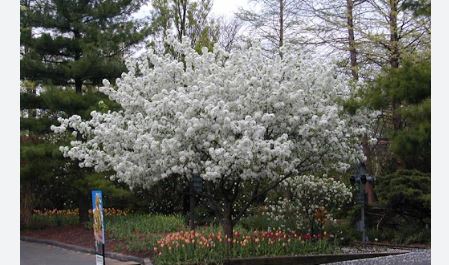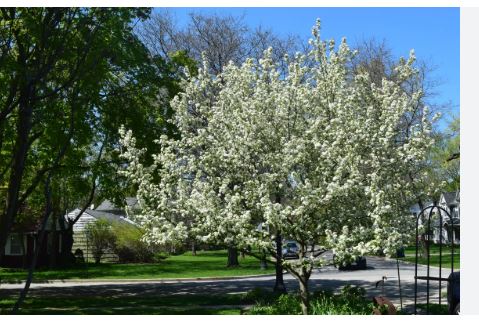
The Donald Wyman Crabapple (Malus ‘Donald Wyman’) is a stunning, disease-resistant ornamental tree celebrated for its profuse white spring blooms, persistent glossy red fruit, and vibrant fall foliage. As a standout cultivar in the Malus genus, this deciduous tree is a favorite among gardeners, landscapers, and urban planners for its year-round appeal, adaptability, and low-maintenance care.
Botanical Classification
The Donald Wyman Crabapple belongs to the following taxonomic classification:
- Kingdom: Plantae
- Phylum: Tracheophyta
- Class: Magnoliopsida
- Order: Rosales
- Family: Rosaceae
- Genus: Malus
- Cultivar: ‘Donald Wyman’
The Malus genus includes both apples and crabapples, with crabapples typically defined by their smaller fruit (less than 2 inches in diameter). The Donald Wyman Crabapple is a hybrid cultivar, likely derived from species like Malus baccata or Malus floribunda, bred for its ornamental qualities, disease resistance, and persistent fruit. Its classification as Malus ‘Donald Wyman’ reflects its cultivated status, with no specific species designation due to its hybrid nature.
History of the Donald Wyman Crabapple
The Donald Wyman Crabapple was discovered as a chance seedling around 1950 at the Arnold Arboretum of Harvard University in Boston, Massachusetts. It was named in honor of Dr. Donald Wyman (1904–1993), a distinguished horticulturist who served at the Arboretum from 1936 to 1970. Wyman, who held a Ph.D. in horticulture from Cornell University, revitalized the Arboretum’s collections and introduced over 1,000 new species and cultivars during his tenure. His passion for flowering crabapples led to the naming of this exceptional cultivar, which was selected for its superior aesthetics and disease resistance. The original tree, still growing along Peters Hill Road at the Arboretum, has endured challenges like Winter Storm Riley in 2018, showcasing its resilience.
Crabapples trace their origins to the mountainous regions of Central Asia, particularly Kazakhstan, where the wild apple species Malus sieversii is native. They spread across Europe and Asia via the Silk Road and were introduced to North America by European colonists in the early 17th century, primarily for cider production. Native North American crabapple species, such as Malus coronaria (sweet crabapple) and Malus fusca (Pacific crabapple), also contributed to the genetic diversity of cultivated crabapples. The Donald Wyman Crabapple represents a modern advancement, combining ornamental beauty with practical traits for contemporary landscapes.
The cultivar has earned prestigious awards, including the 1989 Pennsylvania Gold Medal Award and the Cary Award for plants with superior landscape appeal, winter hardiness, and pest resistance in New England, cementing its status as a top crabapple choice.
Native Area
As a cultivated hybrid, the Donald Wyman Crabapple does not have a true native range but is derived from Malus species native to temperate regions of the Northern Hemisphere, including Central Asia (e.g., Kazakhstan, Russia, and China). Its ancestral roots likely include Malus baccata (Siberian crabapple) or Malus floribunda (Japanese flowering crabapple), both native to Asia.
Native North American species, such as Malus coronaria (eastern U.S.) and Malus fusca (Pacific Northwest and Alaska), may have contributed to its genetic lineage. Discovered in the United States, the Donald Wyman Crabapple is widely adaptable and thrives across North America, particularly in temperate climates.
Identifying Characteristics

The Donald Wyman Crabapple is prized for its elegant form, vibrant seasonal displays, and four-season interest. Here are its key identifying characteristics:
- Size and Shape: This medium-sized deciduous tree grows to a height of 15–25 feet with a spread of 15–25 feet, forming a rounded, spreading, or broadly oval canopy. Its low canopy, with a typical clearance of 4 feet from the ground, makes it suitable for planting under power lines or in urban settings.
- Foliage: The leaves are simple, ovate to elliptical, 2–3 inches long, with serrated margins. They emerge medium to dark green with a glossy finish in spring, maintaining a fresh appearance through summer. In fall, the foliage turns a vibrant amber-gold to yellow, creating a striking contrast with the red fruit.
- Flowers: In mid spring (April–May), the tree produces masses of fragrant, single white flowers (0.75–1 inch in diameter) that emerge from cherry-red or pink buds. The profuse blooms, arranged in clusters, create a snow-like effect, attracting pollinators like bees, butterflies, and hummingbirds. The flowering period is notably long, enhancing its ornamental appeal.
- Fruit: Following the blooms, the tree develops abundant clusters of glossy, bright red pomes (3/8–0.4 inches in diameter), which ripen in early fall and persist into late winter (January–February). These cherry-like fruits are decorative but not typically eaten by birds, contributing to their persistence. The fruits shrivel to half their size before falling, reducing mess.
- Bark: The bark is greyish-brown, smooth when young, and becomes slightly scaly or cracked with age. It adds subtle texture to the winter silhouette.
- Growth Habit: The tree’s rounded, spreading canopy and strong branching create a formal, sophisticated silhouette, ideal for high-end garden designs or as a specimen tree in small spaces. Its low-branching habit may require pruning to maintain clearance for walkways or views.
Uses of the Donald Wyman Crabapple
The Donald Wyman Crabapple is primarily an ornamental tree, valued for its aesthetic contributions and ecological benefits. Its uses include:
- Landscaping: The tree’s vibrant blooms, persistent fruit, and golden fall foliage make it ideal for specimen planting, accent trees, street trees, or group plantings. Its compact size and rounded canopy suit small gardens, urban landscapes, courtyards, or cottage gardens. It can be used in high-end designs, such as secret garden rooms, or planted under power lines due to its moderate height.
- Wildlife Support: The fragrant flowers attract pollinators like honeybees, bumblebees, long-horned bees, and butterflies (e.g., Eastern Tiger Swallowtail, Viceroy). The tree serves as a host plant for numerous moth species, including the Cecropia Moth and Apple Sphinx. While the fruits are not a primary food source for birds due to their bitterness, some species (e.g., starlings, robins) may consume them in late winter after frost sweetens them.
- Culinary Uses: The small, tart fruits are generally unpalatable raw but can be used to make jellies, preserves, sauces, cider, or vinegar due to their high pectin content. Recipes like crabapple coffee cake, fruit leather, or syrup highlight their tangy flavor when sweetened. The fruits’ malic and tartaric acids have historical medicinal uses for digestion and gout relief.
- Pollination: The Donald Wyman Crabapple is self-pollinating but benefits from cross-pollination with other Malus cultivars, enhancing fruit production. It serves as an excellent pollinator for eating apple trees, boosting yields in home orchards. Its long bloom period makes it a reliable pollinator for early- and mid-season apple varieties.
- Urban and Commercial Use: Its high tolerance for urban pollution, drought, and salt spray makes it suitable for city parks, parking lot islands, or streetscapes. The tree’s disease resistance reduces maintenance costs in public spaces.
- Wood: Crabapple wood is hard and aromatic, occasionally used for tool handles or as a smoking wood for foods, imparting a pleasant flavor.
Growth Rate
The Donald Wyman Crabapple has a medium growth rate, adding 10–12 inches per year under optimal conditions. It reaches flowering and fruiting maturity within 3–5 years and achieves its mature height of 15–25 feet in approximately 10–15 years. Under ideal conditions, it can live for 50 years or more, making it a relatively long-lived crabapple compared to other cultivars.
USDA Hardiness Zones
The Donald Wyman Crabapple thrives in USDA Hardiness Zones 4–8, tolerating winter temperatures as low as -30°F and performing well in warm summers. It requires full sun (6+ hours daily) to maximize flowering and fruit production, though it tolerates partial shade with reduced blooms.
The tree prefers well-drained, slightly acidic soils (pH 5.5–6.8) but adapts to a wide range of soil types, including clay, loam, and sandy soils. Once established, it is drought-tolerant and highly tolerant of urban pollution, making it ideal for city environments. It is somewhat tolerant of salt spray, suitable for coastal plantings with protection from heavy exposure.
Fun Fact
The Donald Wyman Crabapple’s original tree at the Arnold Arboretum, discovered in 1950, is still standing along Peters Hill Road, despite surviving significant damage from Winter Storm Riley in 2018. This resilience mirrors the legacy of Dr. Donald Wyman, whose contributions to horticulture included authoring five influential books, such as Wyman’s Gardening Encyclopedia, and introducing over 1,000 new plants to the Arboretum, cementing his status as a horticultural legend.
Care and Maintenance Tips
To ensure the Donald Wyman Crabapple thrives, follow these care tips:
- Planting: Choose a sunny, well-drained site with good air circulation to minimize disease. Dig a hole twice as wide and as deep as the root ball, incorporating peat moss or compost to enrich slightly acidic soil. Plant in spring or fall, ensuring the root ball’s top is slightly above ground level. Water deeply and apply a 2–3-inch layer of mulch, keeping it away from the trunk.
- Watering: Water regularly (weekly, 12–15 gallons) for the first 3–5 weeks after planting, then weekly for the first year until established. Once established, water during prolonged dry spells using the “finger test” (water if soil is dry 2 inches down). Avoid overwatering to prevent root rot.
- Pruning: Prune in late winter or early spring before bud break to remove dead, diseased, or crossing branches, water sprouts, and suckers. Avoid spring pruning to reduce fire blight risk. Minimal pruning is needed to maintain its naturally rounded canopy. Sanitize tools between cuts.
- Fertilization: If planted in fertile soil, fertilization is rarely needed. In poor soils, apply a slow-release, balanced fertilizer (e.g., 10-10-10) or compost in early spring before growth begins. Avoid over-fertilizing to prevent excessive vegetative growth.
- Pest and Disease Control: The Donald Wyman Crabapple has good resistance to apple scab, cedar-apple rust, and powdery mildew but is susceptible to fire blight and leaf scab in humid conditions. Monitor for pests like aphids, Japanese beetles, or spider mites, which are typically minor and can be managed with horticultural soap or beneficial insects.
- Site Selection: Plant 10–20 feet from buildings or other trees to accommodate its mature spread and ensure air circulation. Avoid areas with heavy road salt exposure, as salt tolerance is moderate.
Challenges and Considerations
While the Donald Wyman Crabapple is low-maintenance, consider the following:
- Disease Susceptibility: Though generally disease-resistant, it is susceptible to fire blight and leaf scab in wet, humid climates. Good air circulation and proper pruning reduce risks.
- Fruit Persistence: The persistent fruits are decorative but not typically eaten by birds, reducing mess but limiting wildlife appeal compared to other crabapples. Occasional cleanup may be needed in high-traffic areas.
- Low Canopy: The low-branching habit (4-foot clearance) may obstruct walkways or views, requiring periodic pruning.
- Seed Toxicity: Like all Malus species, the seeds contain trace amounts of amygdalin, which can break down into cyanide if crushed and ingested. The risk is minimal, as the bitter fruits are not typically consumed raw, and whole seeds pass through the digestive system harmlessly.